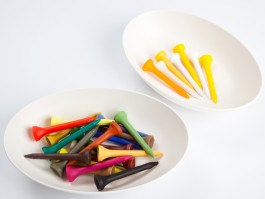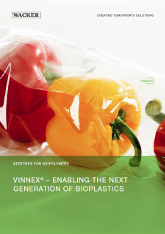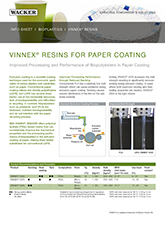Our system has noticed that you are based in , but the current country setting is . Do you still want to change your country?
- Home
- Products & Services
- Applications
- Thermoplastics & Elastomers
- Additives for Biopolymers
Additives for Biopolymers

From compostable packaging to biodegradable plastic cutlery, biopolymers are on the rise. The only limits are technical performance and processability. VINNEX® is a polyvinyl acetate-based additive that allows the combination of several biopolymers, thereby improving performance and processability. With VINNEX®, biopolymers can be processed just like standard thermoplastics. The system makes materials such as starch, polylactic acid (PLA), polyhydroxyalkanoates (PHA), polybutylene succinate (PBS) and cellulose acetates (CA) compatible with each other. This makes it possible to precisely adjust the physical properties as required, while maintaining the biodegradability of the biopolymer blends. In addition, most VINNEX® grades are suitable for use in food-contact applications.
Silicone-based GENIOPLAST® additives enhance the processing and material properties of biopolymers.
Benefits of VINNEX® Powder in Bioplastics – PLA Blends:
- Improved impact strength
- Enhanced flexibility
- Improved compatibility with polar fillers and other biopolymers
- Improved heat sealing properties of films
Benefits of VINNEX® Resins in Bioplastics – PLA Blends:
- Increased melt strength
- Improved processability
- Reduced noise of PLA films
- Maintained transparency
- Good performance in film sealing
- Improved adhesion to paper
Benefits of a combination of VINNEX® and GENIOPLAST® Pellet S or Pellet S Plus for bioplastics:
- Optimized processing properties during extrusion (lower torque, reduced die drool)
- Enhanced scratch resistance
- Enhanced abrasion resistance
- Lower CoF
- Better mechanical properties (increased impact strength and tear strength)
- No impact on transparency
Applications:
- Packaging (cups, bottles, films, trays, shopping bags)
- Textiles (shirts, furniture)
- Nonwovens (diapers)
- Electronics (mobile phone housing)
- Agricultural applications (blend with thermoplastic starches (TPS) for mulch films)
Produktempfehlungen
Für Ihre Filterkriterien und das gewählte Land sind leider keine Ergebnisse verfügbar. Bitte kontaktieren Sie unseren Vertrieb.
|
Produkte
|
Technische Daten
|
Produktmerkmale
|
|
|---|---|---|---|
| Erweichungspunkt | Produkttyp | ||
| VINNEX® 2501 | - - | - | |
| VINNEX® 2502 | - - | - | |
| VINNEX® 2504 | - - | - | |
| VINNEX® 2505 | - - | - | |
| VINNEX® 2522 | 119 °C[1] 246.2 °F[1] | - | |
| VINNEX® 2523 | - - | - | |
| VINNEX® 2525 | approx. 200 °C[2] approx. 392 °F[2] | - | |
| VINNEX® 8802 | approx. 106 °C[3] approx. 222.8 °F[3] | - | |
| VINNEX® 8803 | approx. 118 °C[3] approx. 244.4 °F[3] | - | |
| VINNEX® 8880 | - - | Copolymer Vinyllaurat | |
| VINNEX® eco 2522 (XX MB) | 119 °C[1] 246.2 °F[1] | - | |
| VINNEX® eco 2525 (XX MB) | approx. 200 °C[2] approx. 392 °F[2] | - |
[1] Erweichungspunkt | ASTM D 3104, [2] Erweichungspunkt | DIN ISO 4625, mit Ring und Kugel, [3] Mettler Erweichungspunkt | ASTM D 3104, [] Geeignet, [] Gut geeignet, [] Ideal geeignet
Benefits of VINNEX® Powder in Bioplastics – PHA/PHB Blends:
- Enhanced flexibility
- Improved compatibility with polar fillers and other biopolymers
Benefits of VINNEX® Resins in Bioplastics – PHA/PHB Blends:
- Enhanced flexibility
- Higher mechanical strength
- Increased melt strength
- Optimized crystallinity
- Enables blown film extrusion of PHB films
Applications:
- Cutlery
- Packaging (boxes, bags, foams)
- Mulch films
- Personal care (razors, tooth brush handles)
- Office supplies (pens)
- Golf tees
- Toys
- Household goods
Produktempfehlungen
Für Ihre Filterkriterien und das gewählte Land sind leider keine Ergebnisse verfügbar. Bitte kontaktieren Sie unseren Vertrieb.
|
Produkte
|
Technische Daten
|
Produktmerkmale
|
|
|---|---|---|---|
| Erweichungspunkt | Produkttyp | ||
| VINNEX® 2501 | - - | - | |
| VINNEX® 2502 | - - | - | |
| VINNEX® 2504 | - - | - | |
| VINNEX® 2505 | - - | - | |
| VINNEX® 2522 | 119 °C[1] 246.2 °F[1] | - | |
| VINNEX® 2523 | - - | - | |
| VINNEX® 2525 | approx. 200 °C[2] approx. 392 °F[2] | - | |
| VINNEX® 8802 | approx. 106 °C[3] approx. 222.8 °F[3] | - | |
| VINNEX® 8803 | approx. 118 °C[3] approx. 244.4 °F[3] | - | |
| VINNEX® 8880 | - - | Copolymer Vinyllaurat | |
| VINNEX® eco 2522 (XX MB) | 119 °C[1] 246.2 °F[1] | - | |
| VINNEX® eco 2525 (XX MB) | approx. 200 °C[2] approx. 392 °F[2] | - |
[1] Erweichungspunkt | ASTM D 3104, [2] Erweichungspunkt | DIN ISO 4625, mit Ring und Kugel, [3] Mettler Erweichungspunkt | ASTM D 3104, [] Geeignet, [] Gut geeignet, [] Ideal geeignet
Benefits of VINNEX® Powder in Bioplastics – PLA Blends:
- Enhanced flexibility
- Improved compatibility with polar fillers and other biopolymers
- Increased melt strength
- Improved processability in extrusion and thermoforming
Benefits of VINNEX® Resins in Bioplastics – PLA Blends:
- Enhanced flexibility
- Increased melt strength
- No reduction of hardness or elasticity
Benefits of a combination of VINNEX® and GENIOPLAST® Pellet S or Pellet S Plus for bioplastics:
- Optimized processing properties during extrusion (lower torque, reduced die drool)
- Enhanced scratch resistance
- Enhanced abrasion resistance
- Lower CoF
- Better mechanical properties (increased impact strength and tear strength)
- No impact on transparency
Applications:
- Medical applications
- Disposable tableware
- Compostable bags
- Agricultural mulch films
- Nonwoven fabrics
Produktempfehlungen
Für Ihre Filterkriterien und das gewählte Land sind leider keine Ergebnisse verfügbar. Bitte kontaktieren Sie unseren Vertrieb.
|
Produkte
|
Technische Daten
|
Produktmerkmale
|
|
|---|---|---|---|
| Erweichungspunkt | Produkttyp | ||
| VINNEX® 2501 | - - | - | |
| VINNEX® 2502 | - - | - | |
| VINNEX® 2504 | - - | - | |
| VINNEX® 2505 | - - | - | |
| VINNEX® 2522 | 119 °C[1] 246.2 °F[1] | - | |
| VINNEX® 2523 | - - | - | |
| VINNEX® 2525 | approx. 200 °C[2] approx. 392 °F[2] | - | |
| VINNEX® 8802 | approx. 106 °C[3] approx. 222.8 °F[3] | - | |
| VINNEX® 8803 | approx. 118 °C[3] approx. 244.4 °F[3] | - | |
| VINNEX® 8880 | - - | Copolymer Vinyllaurat | |
| VINNEX® eco 2522 (XX MB) | 119 °C[1] 246.2 °F[1] | - | |
| VINNEX® eco 2525 (XX MB) | approx. 200 °C[2] approx. 392 °F[2] | - |
[1] Erweichungspunkt | ASTM D 3104, [2] Erweichungspunkt | DIN ISO 4625, mit Ring und Kugel, [3] Mettler Erweichungspunkt | ASTM D 3104, [] Geeignet, [] Gut geeignet, [] Ideal geeignet












